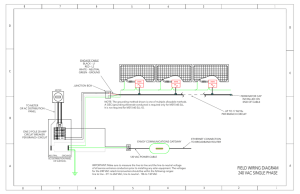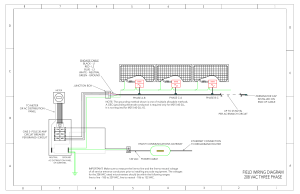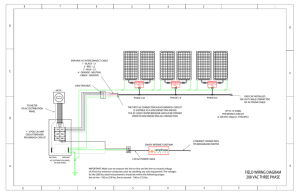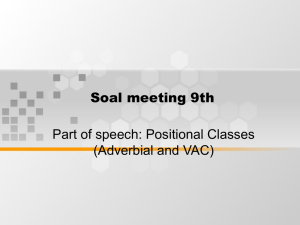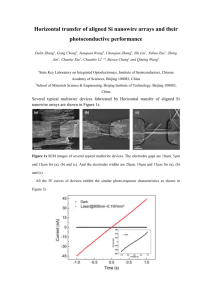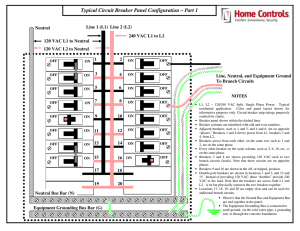MULTIWIRE BRANCH CIRCUIT WIRING
advertisement
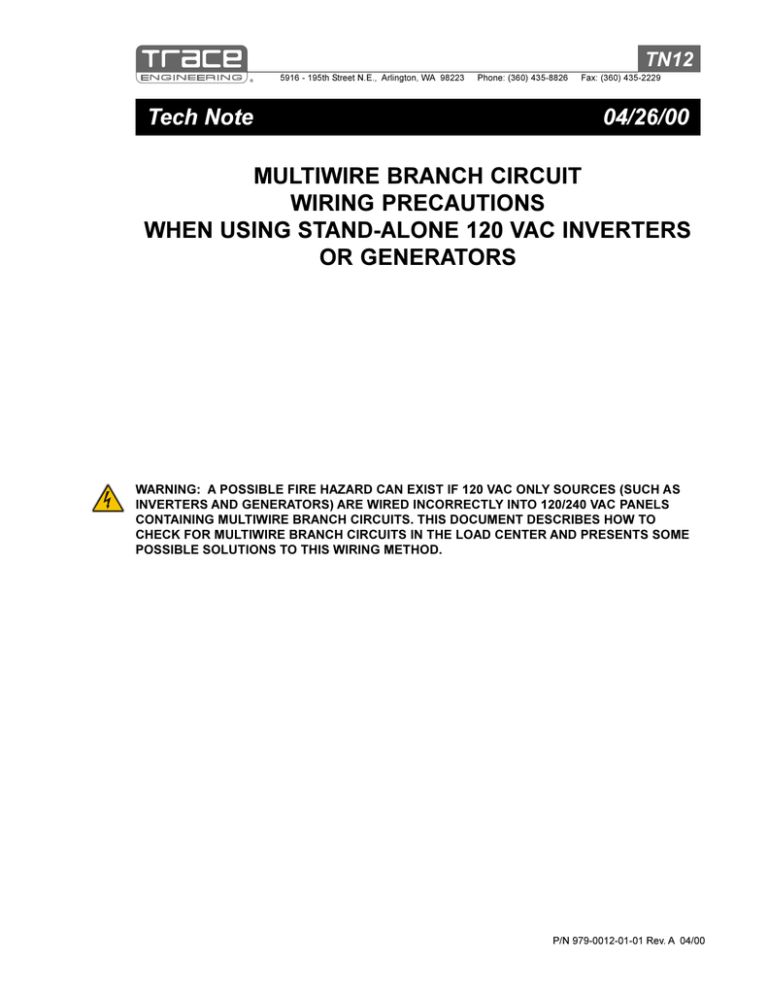
5916 - 195th Street N.E., Arlington, WA 98223 Tech Note Phone: (360) 435-8826 TN12 Fax: (360) 435-2229 04/26/00 MULTIWIRE BRANCH CIRCUIT WIRING PRECAUTIONS WHEN USING STAND-ALONE 120 VAC INVERTERS OR GENERATORS WARNING: A POSSIBLE FIRE HAZARD CAN EXIST IF 120 VAC ONLY SOURCES (SUCH AS INVERTERS AND GENERATORS) ARE WIRED INCORRECTLY INTO 120/240 VAC PANELS CONTAINING MULTIWIRE BRANCH CIRCUITS. THIS DOCUMENT DESCRIBES HOW TO CHECK FOR MULTIWIRE BRANCH CIRCUITS IN THE LOAD CENTER AND PRESENTS SOME POSSIBLE SOLUTIONS TO THIS WIRING METHOD. P/N 979-0012-01-01 Rev. A 04/00 TECH NOTE # 12 Multiwire Branch Circuits A potential safety problem exists when installing stand-alone 120 VAC inverters into existing 120/240 VAC wired panels where multiwire branch circuit wiring methods were used. Multiwire branch circuits are wired differently from home run type wiring (Figure 1) in that only one neutral wire is used to provide the neutral-return path for each circuit connected to both phases of the ac grid. This method has been employed by electricians in recent years to keep construction costs down by saving copper and labor costs involved in running separate romex for each circuit. Under normal conditions, this technique is quite safe and meets code requirements. When used as originally installed, the current for each circuit is 180° out-of-phase with each other, so the neutral wire never receives more current than it was designed to handle as the current from each circuit subtracts (or cancels outleaving only the difference current between the two circuits). Refer to Figure 2. A safety problem occurs when a stand-alone 120 VAC inverter is installed to power these circuits, causing the one neutral wire to now carry the in-phase currents for both circuits. Since the current is in-phase, the two circuits add instead of subtract, potentially doubling the current flow in the neutral return wire! Refer to Figure 3. The branch circuit breakers do not protect the neutral wire from overload under this condition. This excess current will overheat the neutral wire, potentially creating a fire hazard. Load Center 240 VAC from Grid L2 L1 Neutral Ground 25 A Breaker 25 A Breaker 25 A Black–Hot Black–Hot White–Neutral 25 A 120 VAC 120 VAC 25 A White–Neutral 25 A Bare–Ground Bare–Ground 062949-001 Figure 1 Conventional Home-run Type Wiring Load Center Load Center 240 VAC from Grid 240 VAC from Grid L2 L1 Neutral Neutral Ground 25 A Breaker (Ganged) 25 A Breaker (Ganged) Ground Red–Hot Black–Hot 0A The out-of-phase currents subtract at this point L2 L1 Single White–Neutral Bare–Ground 25 A Breaker (Ganged) 25 A Red–Hot Black–Hot 25 A 120 VAC 25 A Breaker (Ganged) 120 VAC Bare–Ground Splice 25 A White–Neutral Splice 062949-002 10 A When unbalanced current flows through each leg, only the difference current flows through the neutral return wire. Single White–Neutral Bare–Ground 25 A 15 A 120 VAC 120 VAC Bare–Ground Splice 25 A White–Neutral Splice 062949-002a Figure 2 Multiwire Branch Circuit Wiring and Current Flow 2 ©2000 Trace Engineering TECH NOTE # 12 Load Center 120 VAC Inverter (or generator) Neutral Ground 25 A Breaker (Ganged) 25 A Breaker (Ganged) 25 A Red–Hot Black–Hot 50 A Single White–Neutral The in-phase currents add at this point exceeding wire capacity! 25 A 120 VAC 120 VAC Bare–Ground Splice Bare–Ground 25 A White–Neutral Splice 062949-003 Figure 3 120 VAC Inverter Incorrectly Wired in a Multiwire Branch Circuit Identifying Multiwire Branch Circuits WARNING: THE NEXT STEP INVOLVES OPENING THE LOAD CENTER EXPOSING LIVE CIRCUITS. THIS PROCEDURE SHOULD ONLY BE PERFORMED BY QUALIFIED PERSONS OR ELECTRICIANS. Multiwire branch circuits can be identified by removing the cover on the load center and inspecting the wiring. Conventional 120 VAC circuits are identified by a 2-wire-plus-ground (black, white and copper) romex for each circuit. Multiwire branch circuits use a 3-wire-plus-ground arrangement (black, red, white and copper) for each circuit run. If this arrangement exists in the panel and it is being powered by a stand-alone 120 VAC inverter, a potential fire hazard exists! For safety, these circuits must be rewired to meet code. Black From L1 Breaker Red From L2 Breaker To Branch Circuits Single Neutral White Ground Bare Copper 062949-005 Figure 4 Multiwire Branch Circuit Wiring ©2000 Trace Engineering 3 TECH NOTE # 12 Correcting Multiwire Branch Circuit Wiring Correcting multiwire branch circuit wiring is not an easy task. There are several approaches that can be taken, each with its advantages and disadvantages. Rewire existing multiwire branch circuits to conventional home run wiring. This requires a qualified electrician (knowledgeable of multiwire branch circuit wiring) and is expensive. There may be multiple multiwire branch circuits located throughout the structure, requiring complete rewiring. Add a second inverter in a series stacked arrangement. This is an expensive solution, but would restore the original 240 VAC split-phase configuration. This solution may actually be less expensive than having an electrician re-wire the multiwire branch circuits, plus it provides increased power backup protection and can power 240 VAC loads. Add a T240 Autotransformer to the output of the inverter to restore the split-phase configuration. This is the least expensive and easiest method to correct for multiwire branch circuit wiring. Refer to Figure 5. Using this method, half of the current is supplied to one leg of the circuit and half to the other in a split-phase arrangement (180° out-of-phase). This will restore the original functionality and safety to the multiwire branch circuit. Load Center Neutral Hot 120 VAC Inverter (or generator) L2 Autotransformer Neutral L1 Ground Hot-L2 Hot–L1 25 A Breaker (Ganged) 25 A Breaker (Ganged) Red–Hot White–Neutral Black–Hot 0A The out-of-phase currents subtract at this point Single White–Neutral Bare–Ground 25 A 25 A 120 VAC 120 VAC Bare–Ground Splice 25 A White–Neutral Splice 062949-004 Figure 5 Using A T240 Autotransformer in Multiwire Branch Circuit Wiring WARNING: UNTIL ONE OF THE SOLUTIONS ABOVE IS IMPLEMENTED, A STAND-ALONE 120 VAC INVERTER (OR GENERATOR) MUST NOT BE INSTALLED WHERE MULTIWIRE BRANCH CIRCUITS EXIST. 4 ©2000 Trace Engineering
